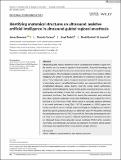Identifying anatomical structures on ultrasound : assistive artificial intelligence in ultrasound-guided regional anesthesia
Abstract
Ultrasound-guided regional anesthesia involves visualizing sono-anatomy to guide needle insertion and the perineural injection of local anesthetic. Anatomical knowledge and recognition of anatomical structures on ultrasound are known to be imperfect amongst anesthesiologists. This investigation evaluates the performance of an assistive artificial intelligence (AI) system in aiding the identification of anatomical structures on ultrasound. Three independent experts in regional anesthesia reviewed 40 ultrasound scans of seven body regions. Unmodified ultrasound videos were presented side-by-side with AI-highlighted ultrasound videos. Experts rated the overall system performance, ascertained whether highlighting helped identify specific anatomical structures, and provided opinion on whether it would help confirm the correct ultrasound view to a less experienced practitioner. Two hundred and seventy-five assessments were performed (five videos contained inadequate views); mean highlighting scores ranged from 7.87 to 8.69 (out of 10). The Kruskal-Wallis H-test showed a statistically significant difference in the overall performance rating (χ2 [6] = 36.719, asymptotic p < 0.001); regions containing a prominent vascular landmark ranked most highly. AI-highlighting was helpful in identifying specific anatomical structures in 1330/1334 cases (99.7%) and for confirming the correct ultrasound view in 273/275 scans (99.3%). These data demonstrate the clinical utility of an assistive AI system in aiding the identification of anatomical structures on ultrasound during ultrasound-guided regional anesthesia. Whilst further evaluation must follow, such technology may present an opportunity to enhance clinical practice and energize the important field of clinical anatomy amongst clinicians.
Citation
Bowness , J , Varsou , O , Turbitt , L & Burkett-St Laurent , D 2021 , ' Identifying anatomical structures on ultrasound : assistive artificial intelligence in ultrasound-guided regional anesthesia ' , Clinical Anatomy , vol. 34 , no. 5 , pp. 802-809 . https://doi.org/10.1002/ca.23742
Publication
Clinical Anatomy
Status
Peer reviewed
ISSN
0897-3806Type
Journal article
Description
This work, undertaken as part of the validation study for medical device regulatory approval, was funded by Intelligent Ultrasound Limited (Cardiff, UK).Collections
Items in the St Andrews Research Repository are protected by copyright, with all rights reserved, unless otherwise indicated.

